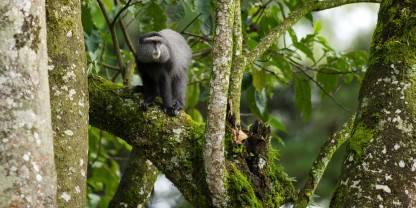Average Expert Rating
Rating Breakdown
Write a User ReviewA Meander Through Spectacular Equatorial Rainforest
Kakamega is one of the last remaining (and fast diminishing) tropical rainforests of East Africa. By walking the narrow winding paths, I always find it such an extraordinarily beautiful and tranquil place. It’s characterised by tangled vines, intermingled branches, a profusion of flowering plants including some exquisite orchids, and a chorus of screeches and mutterings from a whole host of African creatures. The wonderful (mostly self-taught) guides can quite astonishingly reel off the names of the flora and fauna in Latin. Shy forest creatures like blue duiker, bushpig, porcupine and clawless otter are present, but the dense forest floor makes them difficult to see. However, my walks have always been accompanied by monkeys and baboons whooping through the trees and clouds of butterflies. Birds are abundant: a variety of hornbills, woodpeckers, honeyguides, turacos and parrots are among more than 300 species. It’s not easy to get to, and often rainy or misty, but it’s outstanding walking country.
Find Your Inner Tarzan
There are two parts to the forest. The northerly section is a national park and has more pristine forest but higher entry fees and fewer accommodation options. The southerly sector, which is managed by the forest department, is larger and more disturbed, but the choice of accommodation is better and it’s cheaper to visit. Perhaps not surprisingly, then, most people visit this part.
Although the forest in the southern sector is more disturbed, for the average non-expert it’s hard to tell the difference and going on an early morning forest walk with one of the highly knowledgeable guides will reveal birds and monkeys by the tree full.
Read more
As much as anything, what I like about Kakamega is the opportunity to see a very different side of Kenya. These western hills are lush, green and covered in forests, farms and tea estates and the welcome is always genuine and warm. It’s a perfect contrast to the big savannah reserves elsewhere in Kenya.
Forest Birding Mecca!
Kakamega attracts birders from around the world – it is a treasure chest of avian specials. Forest birding is notoriously difficult, so best to hire a local guide as you will hear and see so much more. You should hopefully see the Flintstone-esque great blue turaco flapping around in the canopy, the noisy black-and-white-casqued hornbill, and the grey-throated barbet with its weird feathered bill. If you’re very lucky, you might also see a variety of tiny jewelled wattle-eyes and colourful forest bush shrikes, as well as the blue-headed bee-eater. Three species of monkey are fairly easy to see – black-and-white colobus, red-tailed and blue, and the forest is also a reptile hot spot.
Kakamega is now much more accessible
Read more
thanks to the daily Skyward Express flight from Nairobi – a short 45-minute hop. The taxi drive from the airport along the red mud roads, through the lush forest, passing children walking to school, added to our memorable Kakamega experience.Charming Forest Park in Western Kenya
To me, Kakamega came as a delightful surprise. It’s a small, fragile fragment of what was once an extensive equatorial forest, and is the only reserve of its kind in Kenya. Human pressure has left the forest isolated and endangered, but rare plant and animal species continue to thrive here. There’s a truly peaceful atmosphere among the trees, many of which are satisfyingly ancient-looking, with swirling buttress roots and lofty branches.
Kakamega is very low-key, with modest accommodation, so I’d recommend it to fairly adventurous types who enjoy forest walks among birds, monkeys and butterflies, with or without a guide. Biting insects love this shady habitat and the paths can be muddy, so you need to defend yourself with appropriate clothing and a good repellent.
Kenya’s Top Birding Site
This is one of my favourite reserves anywhere in Kenya, and it is pretty much an essential diversion for any visitor with a serious interest in birds. An isolated western extension of the rainforest belt that extends from Central Africa into Uganda, the reserve protects 400-odd bird species, a list that is dominated by forest specials and includes more than 30 known from nowhere else in the country. The star among these is the great blue turaco, a comically gaudy bird that flops between trees like a colourful turkey, while other avian gems include bar-tailed trogon, blue-headed bee-eater, hairy-breasted barbet and innumerable woodpeckers and greenbuls. Be aware, however, that forest birding can be slow work, so a minimum stay of 2-3 nights is recommended, and it is best to do your walks with one of the excellent local guides. Birding aside, this is a lovely forest, with key mammalian attractions being black-and-white colobus, blue monkey and red-tailed monkey, along with the nocturnal potto, a sloth-like primate whose large eyes are quite easily located by spotlight.

